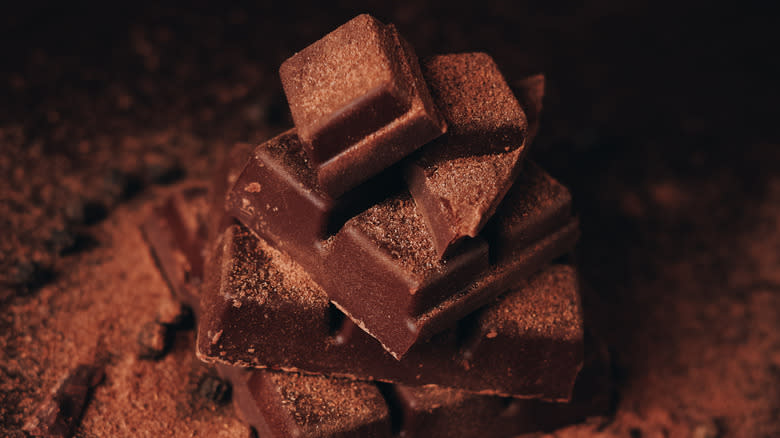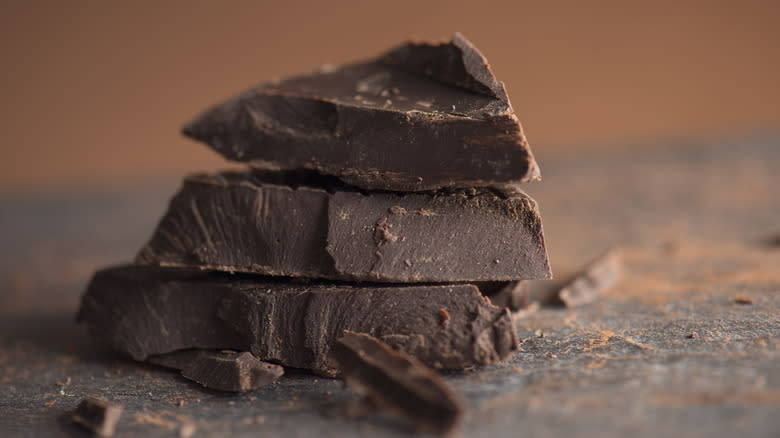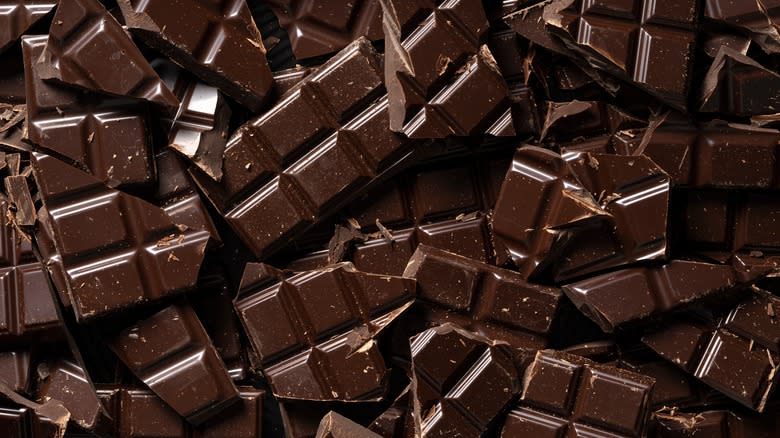Couverture Vs Compound Chocolate: What's The Difference?

Ever found yourself wondering what chocolate enthusiasts are talking about when they argue over what is or isn't "real" chocolate? While definitions of authenticity are highly subjective goalposts best left to personal taste, there are two distinct types of chocolate that people are usually referring to when it comes to "real" or "fake" chocolate: More commonly, these two types are referred to as couverture chocolate and compound chocolate.
The real difference between the two boils down to what kinds of fat were included in the manufacturing process. Any piece of chocolate is composed of chocolate liquor -- which is the chocolate content itself, not to be confused with chocolate liqueur -- and some kind of solid fat. The fat in couverture chocolate is mainly composed of real cocoa butter, which is why many often consider it"genuine" chocolate. Compound chocolate, on the other hand, uses hydrogenated or modified vegetable fats like coconut, palm kernel, or soy oil in place of cocoa butter. While this might seem like a relatively minor substitution, cocoa butter and vegetable fats behave in very different ways when melted down for molding and dipping: If you're picking out a chocolate for making confectionaries with, it's important to understand the pros and cons that come with either type.
Read more: 8 Chocolate Bars That Are Totally Different Outside The US
What Is Couverture Chocolate?

The term "couverture" comes from the French words "chocolat couverture," which translate to "chocolate for covering" due to its popular application as a dipping or coating chocolate. Despite being used internationally to denote high-quality chocolate, it's not a legally recognized category and has no federal regulation or standards in the U.S. However, most bakers and manufacturers simply go by the standards set by the European Union and the World Health Organization: In order for a product to be considered couverture chocolate, it must have a minimum of 35% cocoa solids, and these cocoa solids must be composed of a minimum of 31% cocoa butter.
Because cocoa butter is more expensive than other commercial vegetable fats, couverture chocolate will usually have a much higher price tag than compound chocolates. Depending on what you're using it for, the higher quality may be more than worth the extra cost: The cocoa butter imparts a richer and more complex flavor as well as a smooth and velvety texture.
Having more cocoa butter also makes couverture chocolate capable of being tempered, in which the fat crystals inside cocoa butter set into a rigid and uniform structure. This results in a crisp and glossy finish that can't be fully replicated by compound chocolates -- it's why the "snap" of a chocolate bar will tell you all about its quality.
What Is Compound Chocolate?

Because vegetable fats aren't capable of forming crystallized structures like the molecules in cocoa butter, compound chocolate can't be tempered. Additionally, couverture chocolate owes its smooth mouthfeel to the fact that cocoa butter's melting point is below the human internal body temperature. The fact that the melting point of most vegetable fats falls above human body temperature gives compound chocolates a more awkward mouthfeel that takes longer to melt in comparison.
However, this higher melting point isn't without its advantages. While it can't replicate the snappy firmness of properly tempered chocolate, compound chocolate is naturally solid and firm at room temperature without the need for tempering. Furthermore, it's easy to melt into a smooth consistency and hardens fairly quickly when used as a coating. This makes it a very forgiving ingredient to work with right out of the packaging as opposed to couverture chocolate, which requires tempering to build up any kind of stability. In a somewhat ironic twist of etymology, compound chocolate is also colloquially known as "coating chocolate" due to this ease of handling as a dipping chocolate.
The less finicky nature of vegetable fats in chocolate is also why you might find the addition of vegetable shortening or coconut oil suggested as a cheat, shortcut, or alternative to tempering. It's important to note that, while this will make tempering unnecessary, all you're doing is making compound chocolate that won't quite achieve the gloss and snap of tempered chocolate.
Read the original article on Daily Meal.

